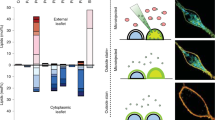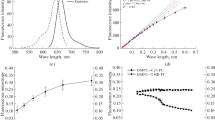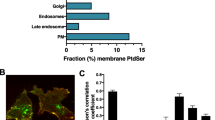Abstract
The fluorescent probe 1,6-diphenyl-1,3,5-hexatriene (DPH) and DPH derivatives have been used to characterize structural and physicochemical properties of specific membrane domains. Steady-state and fluorescence decay measurements of three probes, DPH (1,6-diphenyl-1,3,5-hexatriene), TMA-DPH [1-(4-trimethyl-ammonium-phenyl)-6-phenyl-1,3,5-hexatriene], and a phosphatidylcholine derivative of DPH, DPH-pPC [2-(3-(diphenylhexatriene)propanoyl)-3-pamitoyl-L-α-phosphatidyl choline], have been performed in erythrocyte membranes and in lymphocyte plasma membranes. The steady-state fluorescence polarization of the three probes showed a similar trend in both membranes. In fact either in erythrocyte or in lymphocyte plasma membranes the fluorescence polarization values of DPH-pPC and TMA-DPH were similar, but significantly higher with respect to DPH. A better characterization of erythrocyte and lymphocyte plasma membranes was possible by using fluorescence decay measurements. The data suggest the possible use of different DPH derivatives to characterize specific domains in biological membranes.
Similar content being viewed by others
References
G. Curatola and E. Bertoli (1987) in E. Bertoli, D. Chapman, A. Cambria, and U. Scapagnini (eds.),Biomembrane and Receptor Mechanisms, Liviana Press, Padova, Vol. 7, pp. 143–161.
M. Edidin (1990) in T. Claudio (ed),Current Topics in Membrane and Transport, Academic Press, New York, Vol. 36, pp. 81–95.
C. Zannoni, A. Arcioni, and P. Cavatorta (1983)Chem. Phys. Lipids 32, 179–250.
M. Straume and B. Litman (1987)Biochemistry 26, 5113–5120.
M. Straume and B. Litman (1987)Biochemistry 26, 5121–5126.
J. G. Kuhry, C. Duportail, G. Bronner, and G. Laustriat (1985)Biochim. Biophys. Acta 845, 60–67.
A. Hermetter, E. Kalb, J. Lloidl and F. Paltauf (1988)Proc. SPIE 909, 155–162.
J. G. Molotkovsky, Y. M. Manevich, E. N. Gerasimova, I. M. Molotkoskaya, V. A. Polessky, and L. D. Bergelson (1982)Eur. J. Biochem. 122, 573–579.
J. G. Molotkovsky, Y. M. Manevich, V. I. Babak, V. A. Polessky, and L. D. Bergelson (1984)Biochim. Biophys. Acta 778, 281–288.
J. Kuhry, G. Duportail, C. Bronner, and G. Laustriat (1985)Biochim. Biophys. Acta 845, 60–68.
G. Ferretti, A. Tangorra and G. Curatola (1992)Biochem. Int. 26, 287–296.
T. L. Steck and J. A. Kant (1974) in S. P. Colowick and N. O. Kaplan (eds.),Methods in Enzymology, Academic Press, New York, Vol. 31, pp. 172–173.
V. Kaever, M. Szamel, M. Goppelt, and E. Resch (1984)Biochim. Biophys. Acta 776, 133–143.
O. H. Lowry, N. J. Rosebrough, A. L. Farr, and R. J. Randall (1951)J. Biol. Chem. 193, 265–275.
C. D. Stubbs, K. Kinosita, F. Munkonge, P. J. Quinn, and A. Ikegami (1984)Biochim. Biophys. Acta 775, 374–380.
G. Ferretti, A. Tangorra, G. Zolese, and G. Curatola (1993)Membr. Biochem. 10, 17–27.
M. Shinitzky and Y. Barenholz (1978)Biochim. Biophys. Acta 515, 367.
R. M. Fiorini, M. Valentino, M. Glaser, E. Gratton, and G. Curatola (1988)Biochim. Biophys. Acta 939, 485–492.
J. R. Alcalà, E. Gratton, and F. F. Prendergast (1987)Biophys J. 51, 587–596.
R. A. Parente and B. R. Lentz (1985)Biochemistry 24, 6178–6185.
K. H. Cheng (1989)Chem. Phys. Lipids 51, 137–145.
T. Squier, J. E. Mahaney, J. J. Yin, C. S. Laiù, and J. R. Lacowicz (1991)Biophys. J. 59, 654–669.
E. H. W. Pap, J. J. ter Horst, A. van Hoek, and A. J. W. G. Visser (1994)Biophys. Chem. 48, 337–351.
B. R. Lentz (1989)Chem. Phys. Lipids 50, 171–190.
R. Fiorini, M. Valentino, S. Wang, M. Glaser, and E. Gratton (1987)Biochemistry 26, 3864–3870.
G. Zolese, E. Gratton, and G. Curatola (1990)Chem. Phys. Lipids 55, 29–39.
Author information
Authors and Affiliations
Rights and permissions
About this article
Cite this article
Tangorra, A., Ferretti, G., Zolese, G. et al. Study of plasma membrane heterogeneity using a phosphatidylcholine derivative of 1,6-diphenyl-1,3,5-hexatriene [2-(3-(diphenylhexatriene)propanoyl)-3-palmitoyl-l-α-phosphatidylcholine]. J Fluoresc 4, 357–360 (1994). https://doi.org/10.1007/BF01881456
Received:
Issue Date:
DOI: https://doi.org/10.1007/BF01881456




